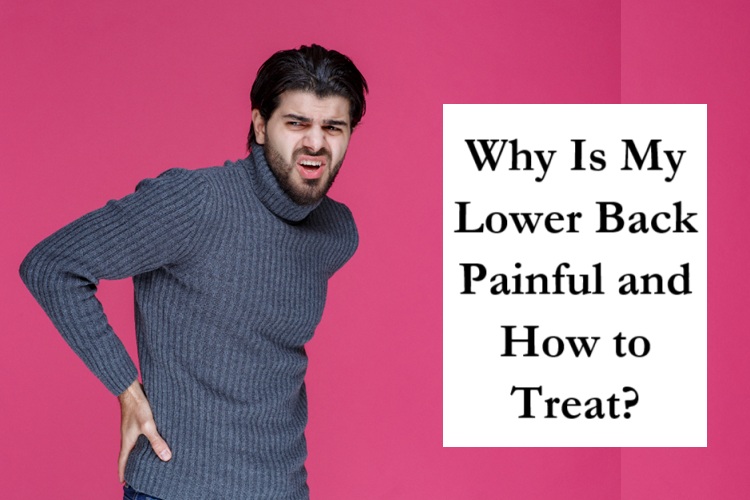It is the most common condition among young adults and senior citizens. Overuse syndrome is the main cause among the working population.
Lower back pain also develops due to more than one internal condition. Neglected injuries are also to blame.
People don’t show enough care after trauma. They use temporary relief options. As a result, the condition grows within, causing chronic pain. Consult a spine specialist immediately for an exact diagnosis and effective treatment.
Anatomy Of Lower Back
The lower back is part of the spine or backbone. It has several components as follows.
- Vertebrae (Small Special Spine Bones)
- Discs
- Ligaments
- Tendons
- Muscles
- Nerves
Causes
The major reasons for lower back pain are as follows.
Overuse: People Lift heavy objects improperly. They don’t maintain good posture while doing desk jobs. Furthermore, there are bad sitting and standing posture techniques. All of these strain the back in the long run.
Trauma: A direct injury to the back leads to damage like fractures, dislocation of vertebral bodies and other soft-tissue problems. Prompt treatment is essential here. Negligence leads to chronic pain and disabilities.
Displacement: It is also known as spondylolisthesis. A vertebral body slips from its usual and right position. This causes impingement to the adjacent nerve roots. Often trauma results in such complications.
Disc Problems: A disc is a flat structure between two vertebral bodies. It has a soft centre and a hard outer shell. Degeneration (wear & tear), bulging, herniation or rupture are major conditions related to an intervertebral disc.
Bad Lifestyle Choices: Smoking, alcohol, sedentary lifestyle, overloaded shoulder bags, etc., contribute to lower back pain. Control bad eating habits as well. Obesity causes various health complications.
Stenosis: The backbone has space called the spinal cavity that encapsulates the spinal cord. When this spinal space gets narrowed to a primary condition (herniated disc, slipped vertebrae, etc.), it puts unhealthy pressure on the nearby nerves. Pinched or compressed nerves cause radiating pain, often known as sciatica. It affects lower back pain, the hip and the parts below.
Symptoms
As per the prevailing cause, the affected person experiences physical symptoms. The pain can be dull, intense, radiating, intermittent or chronic. Sometimes, your pain may worsen with physical activity or specific posture.
Visit the following link. Connect with best spine specialist in Delhi.
Diagnosis
A doctor can order any of the following tests to examine various spine and back conditions.
X-ray: It helps detect vertebral bone and joint conditions with other related abnormalities.
MRI: It is also known as Magnetic Resonance Imaging. This test produces detailed images of spinal bones as well as soft tissues.
CT Scan: If one has a metal implant inside the body, MRI is not the right imaging option. In that case, CT scanning is preferred. This also images bones and soft-tissue parts as effectively as an MRI test.
EMG: It is Electromyography. It is ordered to rule out neurological conditions or neuropathy.
Blood Tests: The pain in the lower back can also be due to genetic complications. These can be well detected via specific blood testing.
Urine Tests: It can help find if the patient is having back pain on either side due to kidney stones.
As per the prevailing symptoms, the doctor will order the required tests.
Treatment
The treatment depends on the condition. The doctor can use conservative, surgical or both options.
Activity Modification & Rest: These two tools provide enough space for healing and rehabilitation. Repetitive movements cause strains and sprains.
Thus, not doing what is causing the problem is known as activity modification. It prevents the straining factor. And, rest helps heal internal damage.
Medications: Anti-inflammatory drugs help relieve pain, swelling and other discomfort.
Injections: Steroids are often injected into painful areas to offer instant relief.
Physiotherapy: This works on structural issues, strained muscles & tendons, overstretching of ligaments, low muscle strength and hampered mobility. Prevention-related education is also its crucial part.
For various back problems, physiotherapy promotes healing, manages symptoms and reduces inflammation, resulting in improved mobility.
Surgery: Sometimes, the invasive option becomes the last resort to offer lasting relief. There are several types of spinal surgeries, for example, discectomy, vertebroplasty, vertebral fusion, lumber decompression surgeries, etc.
Don’t decide on treatment on your own. If the chronic back pain persists and painkillers only provide temporary relief, consult a doctor as soon as possible to get to the exact root cause of the issue.
Risk Factors
You might be more at risk of developing lower back pain if you are surrounded by any or all of the following factors.
- Old Age
- Obesity
- Bad Core Strength
- Comorbidity
- Improper Weight-Lifting Techniques
- Overusing
- Sedentary Lifestyle
Prevention
It is important to take precautions before the condition develops. You might not be able to prevent the condition completely. Yet, doing your best in this regard might reduce possibilities to a considerable extent or degree.
- Take adequate sleep regularly
- Exercise on a daily basis to build core strength
- Incorporate yoga into your life to grow muscle flexibility
- Eat healthy and fresh meals only
- Ensure as much water as necessary throughout the day to prevent dehydration
- Avoid trauma and collisions
- During sports, follow safety measures
- Drive safely since automobile accidents mostly lead to lower spine damage and permanent neurological conditions.
Complications
If you have sustained injuries in the lower back, get medical attention as soon as possible. Negligence can even result in paralysis in the bottom half of the body. You won’t be able to use your lower extremities ever in life.
Refer to the following to book an appointment with the best doctors and surgeons: top orthopedic surgeons in India.
Conclusion
Often lower back pain occurs due to overuse. You might have been overusing your back muscles by sitting improperly for a long time or by repetitive motions. In that case, rest and not engaging in those activities promote healing and offer lasting relief.
However, there are other issues or complications as well that cannot be treated without medical intervention. Thus, if the pain doesn’t go away, consult the right specialist on time.


